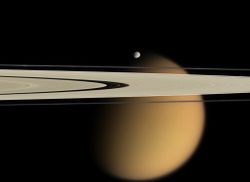Difference between revisions of "Titan"
From FenWiki
m |
Ace Dreamer (Talk | contribs) m (Clarified CHON trade wording.) |
||
| (9 intermediate revisions by 3 users not shown) | |||
| Line 1: | Line 1: | ||
| − | |||
| − | |||
{{planetbox | {{planetbox | ||
| − | |name=Titan | + | |name = Titan |
| − | |image=Titanrings cassini big.jpg | + | |image = Titanrings cassini big.jpg |
| − | |orbit=1,221,870 km from primary (Semi-major axis) | + | |caption = Titan, partially eclipsed by [[Saturn]]'s rings and Epimetheus |
| − | |diameter=5,152±4 km | + | |orbit = 1,221,870 km from primary (Semi-major axis) |
| − | |gravity=0.14 g | + | |diameter = 5,152±4 km |
| − | |year=15.945 days | + | |gravity = 0.14 g |
| − | |day=Synchronous with primary | + | |year = 15.945 days |
| − | |temp=93. | + | |day = Synchronous with primary |
| − | |atmosphere=98.4% nitrogen, 1.6% methane, trace hydrocarbons, cyanoacetylene, hydrogen cyanide, carbon dioxide, carbon monoxide, cyanogen, argon and helium<br />Surface pressure 146.7 kPa | + | |temp = 93.7K (-179.45°C, -291.01°F) |
| − | |waterice=composition ~50%<br />surface coverage ~100% | + | |atmosphere = 98.4% nitrogen, 1.6% methane, trace hydrocarbons, cyanoacetylene, hydrogen cyanide, carbon dioxide, carbon monoxide, cyanogen, argon and helium<br />Surface pressure 146.7 kPa (1.448 atm) |
| − | |population= | + | |waterice = composition ~50%<br />surface coverage ~100% |
| − | |political=[[Fenspace Convention]] | + | |population = 2 (plus tourists) |
| − | |government= | + | |political = [[Fenspace Convention]] |
| − | |capital= | + | |government = Direct Democracy |
| + | |capital = Aria Field | ||
}} | }} | ||
| Line 22: | Line 21: | ||
The name Titan (and the names of all seven satellites of Saturn then known) come from John Herschel's 1847 publication ''Results of Astronomical Observations Made at the Cape of Good Hope.'' He suggested the names of the mythological Titans, sisters and brothers of Cronos, the Greek Saturn. | The name Titan (and the names of all seven satellites of Saturn then known) come from John Herschel's 1847 publication ''Results of Astronomical Observations Made at the Cape of Good Hope.'' He suggested the names of the mythological Titans, sisters and brothers of Cronos, the Greek Saturn. | ||
| − | Titan is the only natural satellite with a natural atmosphere in the Solar system. | + | Titan is the only natural satellite with a substantial natural atmosphere in the Solar system. This atmosphere is the basis of the Outer System part of the [[CHON]] trade, though many of the ships plying this trade don't even need to land. |
== Known Places on Titan == | == Known Places on Titan == | ||
| − | * a base that supports "a small gondolier company" | + | * '''Aria Field''', a base that supports "a small [[gondolier]] company" |
==Related Links== | ==Related Links== | ||
* [[Saturn]] | * [[Saturn]] | ||
* [[Mimas]] | * [[Mimas]] | ||
| − | |||
| − | |||
| − | |||
| − | |||
| − | |||
| − | |||
{{places}} | {{places}} | ||
| − | |||
| − | |||
[[Category:Saturn]] | [[Category:Saturn]] | ||
Latest revision as of 20:05, 5 October 2012
| Titan | |
 Titan, partially eclipsed by Saturn's rings and Epimetheus | |
| Planetary characteristics | |
|---|---|
| Orbit | 1,221,870 km from primary (Semi-major axis) |
| Diameter | 5,152±4 km |
| Surface Gravity | 0.14 g |
| Year | 15.945 days |
| Day | Synchronous with primary |
| Mean Temperature | 93.7K (-179.45°C, -291.01°F) |
| Atmosphere | 98.4% nitrogen, 1.6% methane, trace hydrocarbons, cyanoacetylene, hydrogen cyanide, carbon dioxide, carbon monoxide, cyanogen, argon and helium Surface pressure 146.7 kPa (1.448 atm) |
| Water/Ice Index | composition ~50% surface coverage ~100% |
| Population (2013) | 2 (plus tourists) |
| Political Affiliation | Fenspace Convention |
| Government | Direct Democracy |
| Capital | Aria Field |
Titan, also known as "Saturn VI", was discovered on March 25, 1655, by the Dutch astronomer Christiaan Huygens.
The name Titan (and the names of all seven satellites of Saturn then known) come from John Herschel's 1847 publication Results of Astronomical Observations Made at the Cape of Good Hope. He suggested the names of the mythological Titans, sisters and brothers of Cronos, the Greek Saturn.
Titan is the only natural satellite with a substantial natural atmosphere in the Solar system. This atmosphere is the basis of the Outer System part of the CHON trade, though many of the ships plying this trade don't even need to land.
Known Places on Titan
- Aria Field, a base that supports "a small gondolier company"
Related Links